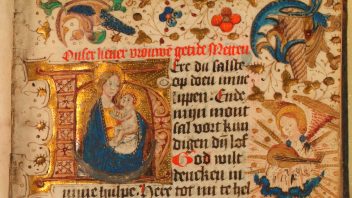eCodicesNL unlocks Dutch medieval manuscripts
Amsterdam, Wednesday 17 May – Today, in collaboration with Athenaeumbibliotheek, Tresoar and Museum Huis van het boek, the Huygens Institute launched the prototype of eCodicesNL, a virtual reading room for medieval manuscripts.
After more than two years of preparation, the Huygens Institute today launched a new digital publication: the prototype of eCodicesNL, a virtual reading room in which 180 medieval manuscripts from three public collections can be viewed. Visitors to the virtual reading room can filter and sort the manuscripts according to different facets, and of course, browse and view them in detail. For example, it is possible to filter out manuscripts in a particular language (Middle Dutch, or Old Frisian), or sort them by penwork decoration or miniatures.
The intention is to gradually expand eCodicesNL with new collections, so that users will eventually be able to consult, browse and research all manuscript collections in the Netherlands in a single interface. To this end, the Huygens Institute has now joined forces with the Royal Library in The Hague: the workflow developed by eCodicesNL for digitising small collections in public institutions will be picked up and continued throughout the country. Later, larger collections will also be covered. The virtual reading room was therefore festively unveiled by Ed van der Vlist, curator of medieval manuscripts at the Royal Library.
This project was realised thanks to funding from the Royal Dutch Academy of Arts and Sciences (Institutes Fund). The three initial partners in the project were the Athenaeum Library in Deventer, Tresoar in Leeuwarden and Museum House of the Book in The Hague. During the course of the project, we photographed manuscripts at House of the Book and Tresoar using a mobile digitising station. The metadata (descriptive data) of all three collections was made available in new standards. The standards used for this purpose are international, sustainable and shareable: IIIF and XML-TEI. Together with software engineers from the Digital Infrastructure (DI) department of the Humanities Cluster, an architecture was designed to bring together the digital images, the metadata and the search interface. This allows visitors to the virtual reading room to lose themselves in medieval texts, parchment quires, illustrated initials or scribbles, doodles and owner’s notes on endpapers.




